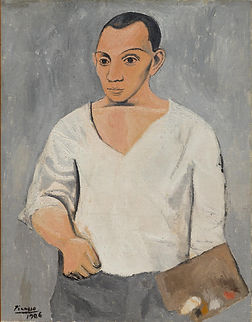Art Gallery: African Art
African Art Period
Even the most talented artist like Picasso didn't create Cubism from anywhere. Now the common understanding of the origin of Cubism comes from African Arts. Those ancient artworks speared in tribes gave Picasso many inspirations. Technically Picasso's paintings created in African Period can be categorized as Cubism. Yet, it is still essential to know how the sculptures from tribes inspire Picasso to build a massive shift in art history.
In the early 19th century, Europeans invaded the African jungle and rooted everything valuable for them. Ivory, Jewelries, and they also enslaved the natives to do the labor. Those are the kind of dirty jobs nobody realized in their homeland. Soon expansive decorations were made by ivories, and the invaders put some of the African tribal arts exhibited in the museums. "This exhibit was so popular that it was decided that the Musee d' Ethnographie du Trocadero would be built to house the collection. Pablo Picasso would later view this exhibit at the Trocadero museum and it would have a profound effect on him and would prove to be pivotal to his art" (Pennisi 2). People criticized the European's invasion for centuries. Nevertheless, those African sculptures give Picasso the basic concept of Cubism.

Musee d’ Ethnographie du Trocadero
If you take a close peek at African traditional art, there are many similarities with cubism. African art is always related to the primitive and wild, and many human signatures are exaggerated. They usually have longer noses, more prominent faces, or asymmetric eyes.
Pablo Picasso visited the museum at age 26; his artworks in The Rose Period and The Blue Period had already gained some fame. Picasso shows that his classical arts degree and skill were better than artists of the same period. Once, Picasso’s friend and sponsor held a weekly salon; Picasso met French artists Maurice Vlaminck, Andre Derain, and Henri Matisse. “They were all part of the fauvist movement. Fauvism was an avant-garde art movement that employed unconventionally vivid and vibrant colors with bold brush strokes” (Pennisi 3). Matisse and Picasso have similar ideologies; they become friends soon, yet Picasso also sees Matisse as his rival. The competition between them gives Picasso many motivations. Matisse will never realize that the African art he introduced to Picasso would be the keystone for Picasso to surpass him and be the most famous artist of the 20th century.
“The effect of this African art upon Matisse and Picasso was entirely different. Matisse through it was affected more in his imagination than in his vision. Picasso more in his vision than in his imagination” (Pennisi 6).

The sculpture that changed the art, it is Seated Vili figure from Congo

1900

1906

1906

1907
From the evolution of Picasso's self portrait, we can see he adds more African art's characteristics into his face. His eyes and nose are all getting bigger.
Gus Casely-Hayford on Matisse and Picasso, discussing how African art infected these two and how their ideology become different.